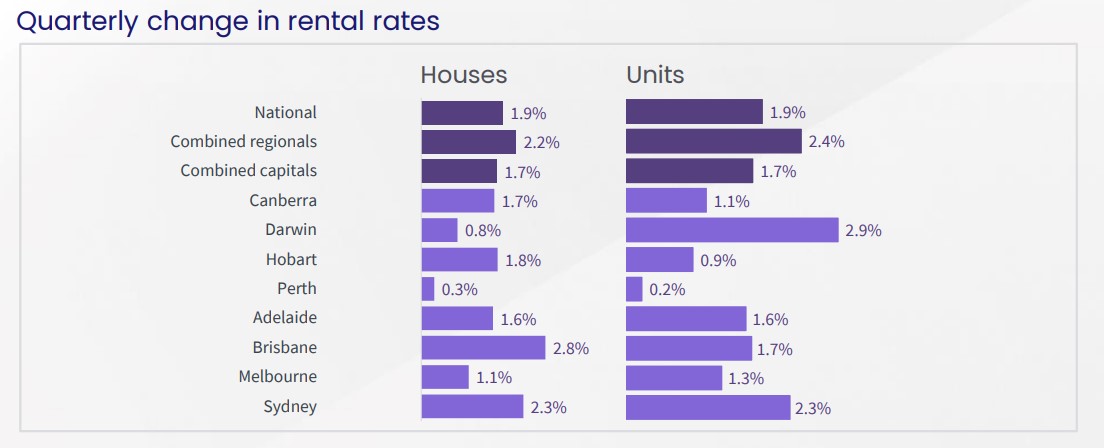Rents are on the rise across Australia
However, growth in rental rates has eased slightly, with the national rental index rising by 1.9% over the September quarter compared to a 2.1% rise over the June quarter.
While we have seen some easing in rental growth, national rental rates are 8.9% higher year-on-year which is the highest annual growth in dwelling rents since July 2008.
Regional rents are rising faster than capital city rents, with regional dwelling rents up 2.2% over the September quarter (down from 2.7% in the previous quarter), while capital city dwelling rents increased by 1.7% over the latest quarter (down from 1.9% over the June quarter).
Regional Australia recorded an annual rate of rental growth of 12.5% in September 2021.
This is the highest annual growth result on record, with the CoreLogic rental index commencing from 2005.
In comparison, the combined capital cities recorded annual rental growth of 7.5% over the same period, the highest annual growth rate for the combined capitals since January 2009.
Following an earlier surge in rents, Perth (0.3%) was the weakest rental market over the September quarter, followed by Melbourne (1.2%) and Canberra (1.5%).
Meanwhile, the strongest quarterly rental growth was recorded in Brisbane (2.6%) and Sydney (2.3%).
Adelaide remains the cheapest capital city for rentals, with typical dwelling rents coming in at $440p/w, which is $193p/w cheaper than the most expensive capital city rental market (Canberra).
Melbourne is the second cheapest rental market, with a typical dwelling costing $450p/w to rent, just $10p/w more expensive than Adelaide.
As mentioned, Canberra is the most expensive rental market, with the median rent for a dwelling at $633p/w, followed by Sydney ($595p/w), Darwin ($561p/w), Hobart ($507p/w), and Brisbane ($491p/w).
Houses vs Units
House rents have been rising at a substantially faster pace than unit rents through the COVID period to date, however, the gap is narrowing as rental demand deflects towards the more affordable unit sector.

Meanwhile, national rental rates have seen annual growth of 10.3% for houses and 5.2% for units over the last 12 months.
The combined capitals recorded weaker quarterly rental growth when compared to the regional markets, with both capital city house and unit rents up 1.7% over the latest quarter.
The combined regional market has seen quarterly rental growth of 2.2% for houses and 2.4% for units.
The combined regional rental index recorded its highest rate of annual growth on record for both houses and units over the 12 months to September.
Rental rates for houses rose by 12.3% annually, while unit rental rates rose by 13.2%.
Looking at the combined capital cities over the same period, house rents increased by 9.5% annually, compared to unit rents which increased by 3.5%.
Melbourne was the only capital city market to see a reduction in unit rents over the 12 months to September 2021, with unit rents down -1.6% annually, however, this is an improvement on the previous quarter when a -6.4% reduction in annual unit rents was recorded in Melbourne.

Across the individual capital cities, Brisbane recorded the strongest quarterly rental growth for houses, rising by 2.8% over the three months to September, with Brisbane house rents now 10.8% higher than this time last year.
Darwin recorded the strongest rental growth for units, rising 2.9% over the September quarter, with unit rents now 20.3% higher than they were one year ago.
Canberra remains the most expensive capital city rental market for both houses and units with a typical house costing $690p/w to rent, and a typical unit costing $533p/w.
Sydney, the second most expensive capital city to rent, is not too far behind, with median rents for houses at $661p/w and $525p/w for units.
In Adelaide, you are looking at paying around $459p/w for a typical house and $371p/w for units, making it the most affordable capital city to rent.
It is $232p/w cheaper to rent a typical house in Adelaide than it is in Canberra, while a typical Adelaide unit is $162p/w more affordable.
National rents rose by 1.9% over the 3 months to September, while dwelling value growth was up 4.8% over the same period, leading gross rental yields to further compress.
National rental yields have been declining on a monthly basis since October 2020, with the national gross rental yield recorded at 3.29% at the end of September 2021, down 12 basis points from June (3.41%), and 48 basis points lower than a year earlier (3.77%).
Across the combined capital cities, gross rental yields were recorded at 3.02% in September 2021 compared to 3.12% the previous quarter and 3.48% a year earlier.
While across the combined regional markets, gross rental yields came in at 4.35% in September 2021, down from 4.51% the previous quarter and 4.93% a year earlier.
Looking at the individual capital cities, Darwin recorded the highest gross rental yields at 6.17%, followed by Perth (4.33%), Adelaide (4.06%), Brisbane (3.93%), Canberra (3.92%), and Hobart (3.89%).
The lowest gross rental yields were recorded in Sydney (2.45%) and Melbourne (2.76%).
With the exception of Darwin (up 9 basis points to 6.17%), gross rental yields were lower across all capital cities over the quarter.
The largest decline was recorded across Hobart, down 30 basis points to 3.89%.
Yields are lower across all markets except Darwin when compared to the same time 12 months ago, with Darwin yielding up 29 basis points year-on-year.
Hobart yields are currently 78 basis points lower than one year ago, followed by Canberra which is down 56 basis points.
Sydney and Melbourne yields are both 49 basis points lower than September 2020, similar to Brisbane yields which are down 47 basis points.
ALSO READ: How (and When) Should You Raise the Rent on Your Investment Property





















